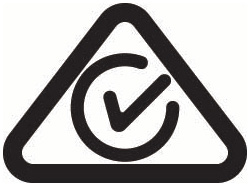This is the top of the main content
Step 7: Label your products
You must label any products you intend to sell with a compliance mark before you can supply them to the market.
Why label
Labelling a product with a compliance mark indicates that the product complies with the relevant requirements. In New Zealand products can be labelled with one of two compliance marks — the Regulatory Compliance Mark (RCM) or the R-NZ.
Using the RCM
For radiocommunications and EMC products where the level of conformity is 1, 2 or 3, you need to use the RCM.

The Regulatory Compliance Mark
You can only use the RCM if you’re registered with the Electrical Regulatory Authorities Council (ERAC) and have a supplier number.
See Step 6: Become a registered supplier for how to do this.
How to use it
We encourage you to show that your products comply with New Zealand’s EMC standards by using the RCM on your:
- advertising
- packaging
- displays
- warranty forms
- instruction leaflets
- websites.
Seeing the RCM helps consumers choose products that pose minimal risk to the radio spectrum.
Download a copy of the RCM [ZIP, 102 KB]
Using the R-NZ
When the product is a radio transmitter in a class where the level of conformity is A1, A2 or A3, you need to use the R-NZ compliance mark, not the RCM. The R-NZ is a New Zealand-only radio label for radio products not harmonised with Australia.
R-NZ
Labelling requirements
Labels must be legibly and durably applied on an external surface of a product. A label must be:
- no smaller than 3mm in height for the compliance mark or the characters R-NZ, and
- 1mm in height for the supplier identification.
If it’s not practical to apply the compliance mark to the product, you can use an alternative labelling method. The compliance mark can be applied:
- to the outer surface of the packaging
- to the instructions for use
- to the product’s guarantee or certificates.
Electronic labelling
If a product has a built-in display, it can be labelled electronically as long as:
- the documentation accompanying the product explains how the compliance mark is applied
- the compliance mark is applied to the product in a way that would make it difficult to delete, modify, or prevent it displaying.
Labelling exemptions
New Zealand has mutual recognition agreements with Australia and China, which provide some labelling exemptions.
Products are exempt from New Zealand labelling requirements if they were supplied in accordance with:
- Radiocommunications Regulations (Mutual Recognition: Australia) Notice 2008(external link)
- Radiocommunications Regulations (Mutual Recognition: People's Republic of China) Notice 2008(external link)
See Our role in the international community for more information on mutual recognition agreements.
Parallel importing
When you parallel import an EMC product, it may already be factory labelled with the other supplier's label. Unlike intermediate suppliers, like wholesalers and retailers, you’re unlikely to have an agreement with the other importer who has labelled the product.
If you parallel import an EMC product that has been factory labelled by another supplier:
- If the product is already labelled with the RCM, you:
- don’t need to do any additional labelling, but
- do need to create compliance documentation for the product.
- If the other supplier has used a C-tick instead, you'll need to:
- label the product with the RCM, and
- create compliance documentation for the product.
If you parallel import a radio product that has been factory labelled by another supplier:
- If the product is already labelled with the R-NZ, you:
- don’t need to do any additional labelling, but
- do need to create compliance documentation for the product.
- if the other supplier has used the SCN label instead, you'll need to:
- label the product with the RCM, and
- create compliance documentation for the product.

